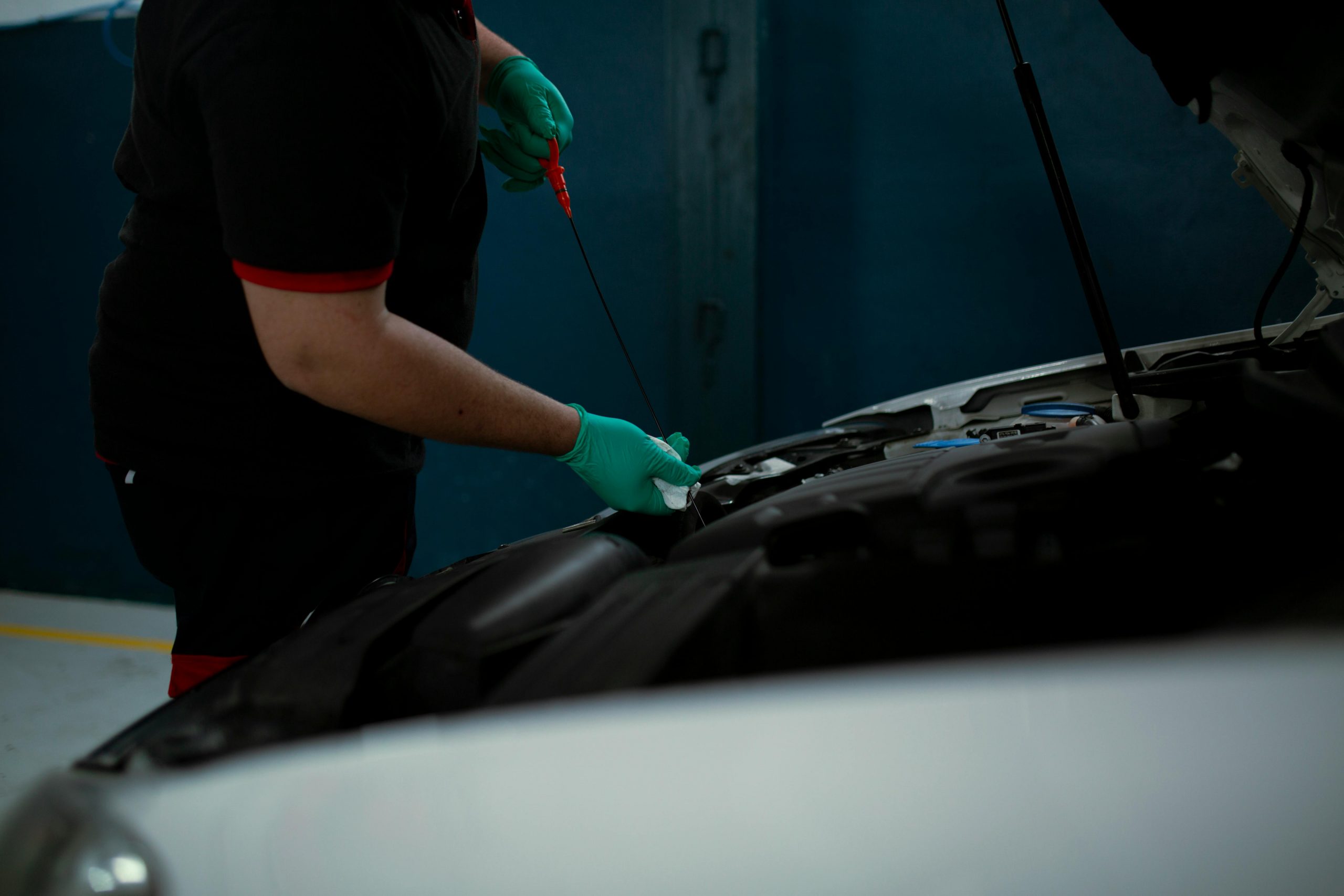Keeping your engine healthy starts with something quick and easy: checking your oil. Whether you’re driving a brand-new SUV or a 10-year-old sedan, knowing how to read an oil dipstick can save you from costly repairs.
In this guide, we’ll walk you through what an oil dipstick is, why it’s important, when and how to check your oil, and what signs to look for. It only takes a few minutes, and it can help you avoid serious engine damage.
What Is an Oil Dipstick?

An oil dipstick is a long metal rod that goes into your engine’s oil reservoir. It helps you check both the oil level and oil condition in your car.
One end of the dipstick has a handle or ring you pull out. The other end has markings that show whether your oil is at a safe level. It’s one of the easiest tools to use when it comes to basic car maintenance.
Why Checking Oil Is Important
Motor oil is the lifeblood of your engine. It helps keep all the moving parts working together without causing damage. Every time your engine runs, oil flows through it to perform several key functions that keep your car running efficiently and safely.
Here’s what motor oil does for your engine:
- Lubricates engine parts: Oil creates a thin barrier between metal parts to prevent them from grinding against each other. This reduces friction and helps the engine run smoothly.
- Cools the engine by reducing friction: As the engine runs, it generates heat. Oil absorbs and carries away some of that heat to help prevent overheating, especially during long drives or in hot weather.
- Cleans out dirt and debris: Oil traps small particles like dust, metal shavings, and sludge. It carries them to the oil filter, which keeps the engine clean and prevents buildup.
- Protects parts from wear and corrosion: Clean oil helps reduce rust and wear over time, protecting your engine from long-term damage and extending its lifespan.
If your oil gets too low, too dirty, or too old, it can’t do these jobs properly. That puts your engine at risk for serious problems like overheating, increased wear, and even total engine failure.
That’s why learning how to read oil dipsticks correctly—and checking your oil regularly—is one of the simplest but smartest things you can do as a car owner. It only takes a few minutes and could save you thousands of dollars in repairs.
When to Check Your Oil
Checking your oil regularly is a simple habit that can help you avoid big engine problems down the road. You don’t need to check it every time you drive, but keeping a routine helps you spot low or dirty oil before it becomes a serious issue.
Here are some simple rules for when to check your oil:
- Once a month: A quick monthly check helps you catch any slow leaks, oil loss, or signs of dirty oil. Even newer vehicles can use or burn oil over time, so it’s smart to check it regularly.
- Before long trips: If you’re heading out on a road trip or driving long distances, check your oil beforehand. It’s important to make sure everything is topped off and running properly before you hit the highway.
- If the oil light comes on: Don’t ignore your dashboard warning lights. The oil light may signal that the oil level is low, the oil pressure is off, or there’s a problem with the oil sensor. Always stop and check the dipstick if this light appears.
- After your car has been sitting for a while: For the most accurate reading, wait until your car has been parked and turned off for at least 5–10 minutes. This allows the oil to drain back into the oil pan so you can see the true level.
Pro tip: Always check the oil when the engine is cool and the car is parked on a flat, level surface. Checking while the engine is hot or while parked on a hill can give a false reading and make it harder to get an accurate measurement.
Step-by-Step: How to Read an Oil Dipstick

Checking your oil may seem intimidating if you’ve never done it before, but it’s actually really simple. Follow these steps:
Step 1: Turn Off the Engine & Let It Cool
Park your car on a flat surface. Turn off the engine and wait at least 5–10 minutes so the oil can settle into the pan. Checking it while it’s hot or running can give you the wrong reading—and it’s not safe.
Step 2: Open the Hood
Pull the hood release lever inside your car (usually near the driver’s seat). Go to the front of the car, unlock the hood latch, and lift the hood. Use the hood prop if your car has one.
Step 3: Locate the Dipstick
Look for a colored or labeled handle—often yellow, orange, or red. It may be marked “Engine Oil.” If you’re not sure, check your owner’s manual.
Step 4: Pull Out the Dipstick
Slowly pull the dipstick all the way out. It might have oil on it, but don’t read it yet!
Step 5: Wipe It Clean
Use a clean rag or paper towel to wipe off the end of the dipstick. This gets rid of oil splatter so you can get a clear reading.
Step 6: Reinsert the Dipstick Fully
Push the dipstick all the way back in until it’s seated completely. Wait a second, then pull it out again.
Step 7: Read the Oil Level
Look at the tip of the dipstick. You’ll see two marks or lines—often labeled “MIN” and “MAX,” “L” and “H,” or shown as holes, notches, or crosshatch areas.
The oil level should be:
- Between the two marks = Good
- Below the lower mark = Add oil
- Above the upper mark = Too much oil (can also be bad)
If the oil level is below the safe zone, it’s time to add the right type of oil for your vehicle.
Step 8: Check the Oil Condition
In addition to level, pay attention to how the oil looks and smells:
- Golden brown or amber = Normal, clean oil
- Dark brown or black = Old oil, time for a change
- Milky or foamy = May indicate coolant leak
- Burnt smell = Oil is breaking down, may harm engine
If the oil looks dirty or smells burnt, consider changing your oil even if the level is okay.
What If the Oil Level Is Low?
If the oil is below the low mark, you need to add oil. Here’s how:
- Check your owner’s manual for the correct type of oil (like 5W-30 or 10W-40).
- Remove the oil filler cap (usually marked “Engine Oil”) on top of the engine.
- Use a funnel to pour in a little at a time—about half a quart to start.
- Wait a few minutes, then check the dipstick again.
- Add more if needed, but don’t overfill.
Common Mistakes to Avoid
Here are a few things to watch out for when learning how to read an oil dipstick:
- Checking when the engine is hot: Can give false readings and burn your hands
- Not wiping the dipstick first: Makes it hard to get an accurate result
- Adding too much oil: Can cause leaks or engine damage
- Using the wrong type of oil: Check your manual to be sure
- Forgetting to check regularly: Leads to running on dirty or low oil
How Often Should You Change Your Oil?
While reading the dipstick helps you check oil level and quality, you still need to change your oil regularly. For most vehicles:
- Every 5,000 to 7,500 miles for synthetic blends
- Every 3,000 miles for conventional oil
- As needed if oil appears dirty, smells burnt, or looks sludgy
If you drive in harsh conditions like extreme heat, cold, or dusty roads, you may need to change your oil more often.
What If You Don’t Have a Dipstick?
Some newer vehicles no longer have a physical dipstick. Instead, they use electronic oil level sensors.
If your car has this feature:
- Check oil using the dashboard menu or touchscreen display
- Look for alerts that say “Oil Level Low” or “Check Engine Oil”
- Follow the same safety steps when topping off oil
Your owner’s manual will explain how your car monitors oil and where to check it.
When to See a Mechanic
If you notice any of the following after checking your oil, it’s time to visit a professional:
- Oil looks milky or foamy (could mean coolant leak)
- You have to add oil too often (may be a leak or burning oil)
- The dipstick is dry, even after topping off
- Strange noises, smells, or poor engine performance
Final Thoughts
Now you know how to read oil dipsticks like a pro! It’s a simple skill that only takes a few minutes, but it can make a big difference in keeping your engine healthy and running smoothly.
By checking your oil once a month, staying within the safe range, and paying attention to the color and smell of your oil, you’ll avoid many common engine problems. And if you’re ever in doubt, a quick visit to your mechanic can help.
Taking care of your car doesn’t have to be hard—and it starts with just one dipstick.
